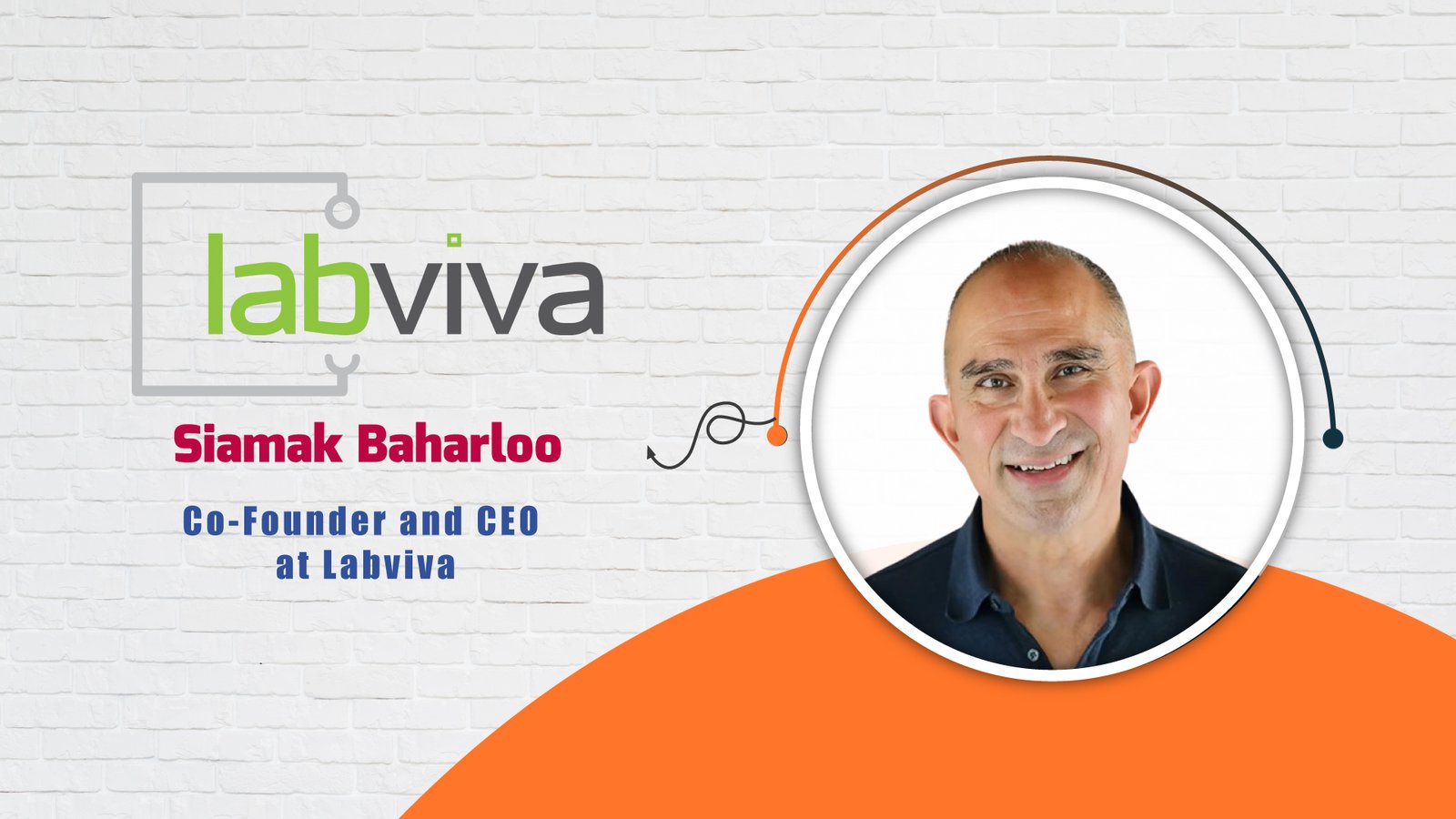Siamak Baharloo, co-founder of Labviva, shares how AI is transforming life sciences procurement, boosting supplier diversity, sustainability, and efficiency. Discover his journey and insights.
Siamak, could you share your professional journey and what inspired you to co-found Labviva?
I’ve spent my career at the intersection of science, technology, and business—driven by a mission to accelerate discovery in life sciences. I’m a trained geneticist with a strong foundation in research. After grad school, I joined a bioinformatic startup in the Bay area and learned more about the business side of science. This sparked my interest in developing technology to build informatic applications to address scientific problems.
So I shifted my focus and spent the past 20 years building and running marketing and ecommerce channels for major life science companies like Life Technologies, ThermoFisher Scientific, Milipore Sigmna, and Sartorius. I’m passionate about helping scientists like me solve problems more quickly by giving them the tools to automate manually intensive tasks like product discovery, pricing comparisons, and inventory replenishment. I want to make an impact in life sciences by building SaaS solutions that deliver mass efficiencies to research labs around the world.
The concept of Labviva was inspired after recognizing the many shortcomings in life science procurement. Large pharma, biotech, and university research organizations need access to thousands of products but rely heavily on a few major distributors, which adds unnecessary cost and complexity. Labviva simplifies that extra layer by connecting buyers directly with 90% of the world’s life sciences manufacturers, offering diversity, contract pricing, and streamlined purchasing.
Labviva’s goal is to empower customers with transparency, control, and a more intuitive, science-driven interface to find and purchase the right products based on what matters most to them – cost, speed, sustainability, or supplier diversity.
Traditional procurement practices in the life sciences industry often favor large distributors. What are the key consequences of this bias, and how does it limit the potential for supplier diversity?
Favoring large distributors, many of which are vertically integrated, limits competition by prioritizing their own manufactured products over those from independent suppliers. This limits product access, which may not serve their best interest in each application, and adds layers of cost, leading to higher prices while reducing visibility and access to smaller vendors. Since large aggregators often lack local presence and supplier diversity, this may lead to restricting access to green, local, or diverse minority-owned businesses. Shifting to more open procurement models can provide broader supplier access, better pricing, and alignment with diversity and sustainability goals.
How can AI-driven tools help life sciences companies overcome traditional practices and make more informed, data-driven sourcing decisions?
AI tools can help life sciences achieve mass efficiencies and cost savings over traditional legacy sourcing practices in multiple ways, including the following:
- AI and machine learning (ML) aggregate and analyze data like product attributes, peer-reviewed literature, and usage context to give scientists a more complete picture of each item’s efficacy and history. This saves scientists thousands of human hours each month by automating manual tasks like product search and selection, allowing them to spend less time on administrative tasks and more on research.
- AI analyzes tens of thousands of transactions to provide accurate delivery estimates—often more reliable than supplier promises—by identifying actual shipping patterns.
- AI monitors usage trends and supply chain availability to optimize inventory management replenishment schedules. This also saves scientists and procurement professionals hours of manual oversight by preventing stockouts, over-ordering, and waste while ensuring the best pricing and fulfillment performance.
How can AI and data analytics enable companies to identify and engage with diverse suppliers?
AI helps by aligning supplier data with each customer’s specific definitions of “diverse,” “green,” or “local.” These definitions vary—for example, “local” might mean within 200 miles for one customer or within five miles of a site for another. AI agents analyze supplier attributes and tag them accordingly, ensuring companies can identify and engage with suppliers that meet their unique criteria.
Supplier diversity about resilience and fairness. How can diversifying the supplier network help mitigate supply chain risks?
As we saw during the COVID-19 pandemic, relying on only a handful of suppliers can make companies vulnerable during disruptions. Diversifying creates redundancy, ensuring alternate, pre-approved sources are available when needed. While managing more suppliers typically adds administrative burden, Labviva handles the contracting, catalog management, and logistics, so customers gain supply chain resilience without the extra overhead.
How can technology and AI-driven procurement solutions help level the playing field for local suppliers facing barriers when entering the life sciences procurement space?
Smaller manufacturers often struggle to access large buyers like big pharma or research institutions due to limited resources to enter the market. As a result, they rely on distributors and aggregators. AI-driven procurement platforms level the playing field by giving them direct visibility within procurement systems, equal product representation, and access to customer analytics. AI harmonizes data—like part numbers and units—so offerings from smaller manufacturers can be compared alongside major suppliers, helping them compete more effectively and build stronger customer relationships.
Sustainability is becoming a key consideration in procurement. How can AI be leveraged to help companies incorporate more sustainable practices?
AI can gather and analyze complex, often fragmented data—like sourcing locations, manufacturing processes, carbon footprint, transportation routes, and disposal methods—to assess a product’s sustainability and provide sustainability-driven recommendations. It can even tell you how many ports the item has been transmitted through, how many miles it has traveled, and if it was transported by land, air, or sea. By piecing together this information, AI provides buyers with a clearer, more complete picture of whether suppliers meet their environmental criteria, something that’s difficult and time-consuming to do manually.
What challenges do procurement teams face when implementing AI-driven tools, and how can they overcome these obstacles?
There are two types of AI in procurement: analytics-driven and generative. Analytics AI is widely used to analyze spend, build supplier profiles, and optimize supply assurance. Generative AI is newer to procurement, with early use cases in areas like support and communication.
We build AI into our platform, powering data aggregation, normalization, and workflow automation behind the scenes. It can even layer directly on the organization’s procurement system. This means users benefit from advanced AI without needing to implement or interact with it directly, reducing complexity and easing adoption.
How do you see AI and data analytics shaping the evolution of procurement in the life sciences industry?
AI will play a significant role in shaping the evolution of procurement by giving life science companies deeper visibility into their spending, usage patterns, purchasing behavior, supply chain dynamics, and shifting research needs—insights they often lack today. Instead of relying on outdated or supplier-provided data, AI enables predictive analytics that help procurement teams proactively onboard the right suppliers and products, negotiate better contracts, and stay ahead of internal demand as research evolves.
What advice would you give to procurement professionals who are looking to adopt AI-driven tools to enhance their sourcing strategies, improve supplier diversity, and ensure sustainability?
My advice is to embrace AI-driven tools to elevate procurement from a transactional role to a strategic function. By improving access to supplier data, optimizing pricing, and ensuring supply continuity, procurement teams can significantly reduce manual overhead and enhance the researcher experience. This shift drives financial efficiency and empowers scientists to focus on their core mission—advancing science—instead of getting bogged down in purchasing tasks.

Siamak Baharloo
Co-Founder and CEO at Labviva
Siamak is a geneticist by training and a life science marketer by trade. He has more than two decades of experience leading digital marketing and eCommerce channels for major life science companies, including Thermo Fisher Scientific, Life Technologies, MilliporeSigma, and Sartorius. Siamak holds a PhD in human and medical genetics from the University of California, San Francisco (UCSF). Throughout his career, he has developed innovative strategies for marketing to the highly sophisticated and technical audience of life scientists, setting the standard in the life sciences sector.
Company Profile: Labviva is an AI-powered digital purchasing platform for the life sciences industry. It aims to revolutionize life sciences procurement by providing a platform for scientists and technical users to search, identify, and procure products from various suppliers. Labviva leverages AI to improve procurement processes, helping laboratories optimize purchasing, track supply chains, and manage inventory more effectively.

